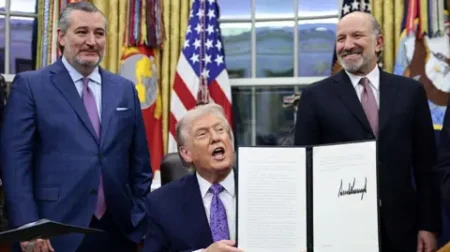In a surprising turn of events, the Mexican government has taken issue with a recent decision by Google Maps to rename the Gulf of Mexico to the Gulf of America. This unexpected shift follows the signing of an executive order by former U.S. President Donald Trump during his initial week in office. The directive mandates that the body of water, which connects the shores of the United States, Mexico, and Cuba, bears the new name within U.S. borders, while retaining its original designation internationally.
The controversy has sparked significant dialogue around sovereignty and the authority to name geographical features. Mexican President Claudia Sheinbaum has formally approached Google with a request to reconsider the name change. Her appeal is rooted in the argument that the United States does not possess the legal jurisdiction to rename the Gulf of Mexico, citing the United Nations Convention on the Law of the Sea. This international treaty stipulates that a nation’s territorial waters extend only 12 nautical miles offshore, which complicates any claim that the name could solely reflect U.S. interests.
In her communication, President Sheinbaum emphasized that changes to geographical names should not be subject to the influence of any single country’s mandate, especially for a significant international body of water like the Gulf of Mexico. She stated, “The name change could only correspond to the 12 nautical miles away from the coastlines of the United States of America,” reinforcing Mexico’s claim to its historical and cultural recognition of the gulf.
Interestingly, Google has yet to publicly respond to the controversy; however, a statement on social media from the company indicated their policy of aligning name changes with updates from official government sources. In cases where names differ internationally, Google Maps displays the name relevant to the user’s location. This implies that while users in the U.S. may see the Gulf marked as the Gulf of America, international users will continue to identify it as the Gulf of Mexico.
Debate over geographical nomenclature often evokes national pride and identity, as further illustrated by President Sheinbaum’s lighthearted take on the situation. Amidst her criticisms, she made a joke suggesting that if Trump could alter the name of the gulf, Mexico might as well propose that “Mexican America” be added to maps. “By the way, we are also going to ask for Mexican America to appear on the map,” she quipped, hinting at a broader discussion about the cultural landscape of North America.
This incident not only points to the complexities surrounding geographical naming rights but also opens a dialogue about how different nations perceive their borders and influence. Sheinbaum previously commented on Trump’s order by asserting, “For us it is still the Gulf of Mexico, and for the entire world it is still the Gulf of Mexico,” signaling that while political administrations might attempt to impose changes, the enduring names often reflect a deeper historical context.
The episode recalls former events where political leaders attempted to assert control over geographical names, revealing the intersection between geography and identity, as well as the potential for a dispute over such a seemingly simple issue as a name change. As the situation unfolds, many are watching to see how Google will navigate this sensitive dilemma and whether they will uphold their policy of aligning with international naming conventions amidst nationalistic pressures.
In conclusion, the name change of the Gulf of Mexico reflects broader themes of nationalism, legal authority, and cultural heritage. The outcry from Mexico represents not just a defense of a geographical label, but a stand for international respect and historical recognition. As geographical features often embody the identities of the nations they touch, this debate could lead to consequential discussions about sovereignty, identity, and the role of technology companies in shaping our maps and, by extension, our understanding of the world’s geography.











